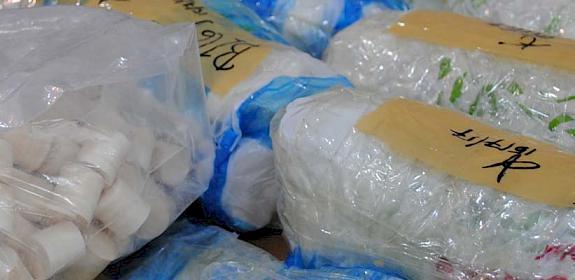Customs Department and TRAFFIC set a course to fight illegal ivory trade
Kuala Lumpur, Malaysia, 9th September 2013—For the first time since the Royal Malaysian Customs began its string of large-scale seizures of ivory transiting through the country, over 30 of its frontline officers took part in a workshop to understand the dynamics and tackle the illegal ivory trade.

The workshop, jointly organized by the Royal Malaysian Customs Department and TRAFFIC will be held in two phases and see a total of 70 officers from Peninsular Malaysia, Sabah and Sarawak participate.
They will receive ivory identification training; discuss smuggling techniques and routes as well as opportunities and solutions towards ending Malaysia’s role as a transit hub for illicit ivory.
The 70 officers include those specifically assigned to oversee the implementation of the Convention on International Trade in Endangered Species of Wild Fauna and Flora (CITES) regulations as well as risk assessment officers stationed at some of the country’s busiest ports, including those that have intercepted illegal ivory shipments in the past.
During the workshop information will be shared with the Department of Wildlife and National Parks, which manages the seized stockpiles of ivory; and PALF, the Project for the Application of Law for Fauna, an organization based in the Republic of Congo that has worked closely with other governments and institutions across Africa on wildlife law enforcement, including successful ivory seizures. PALF is part of the Eagle Network – a network of projects reinforcing the application of wildlife law.
Togo, in West Africa, was listed as the country of origin for the largest ivory shipment ever seized in Malaysia. That six-tonne seizure in Port Kelang in December 2012 represented almost half the volume of all ivory seized in Malaysian ports since July 2011.
Over the last five years, close to 45 tonnes of African Elephant ivory has either been seized in Malaysian ports, transited through them before being seized elsewhere or has been specified as the intended destination on shipping documents seized at the point of origin.
“Malaysian ports and airports, due to their strategic location, feature as an inevitable transit or transhipment point for the trade in most goods between Africa and the Far East. While ivory is not traded domestically or has spurred domestically viable industries in Malaysia unlike the huge demand for this commodity seen in countries in the region, the Royal Malaysian Customs is however in the position to assist the international community in combating the illegal trade in ivory,” said Dato’ Hj Zainul Abidin bin Taib, Assistant Director-General of Customs of the Enforcement Division of the Royal Malaysian Customs Department.
“We hope to see results from this collaboration with TRAFFIC by bringing the awareness of the ivory trade to Custom officers at ports which have seen large seizures of ivory. We will also engage TRAFFIC to assist in the development of a Customs Wildlife Enforcement Training Program at our Customs Training Academy as well as a Species Identification Course for Customs Border Control Officers that will complement CITES compliant prohibitions in the new Customs prohibition laws that has come into force this year. We will continue to work with international monitors whose assistance has led to the interception and seizures of ivory in transit by custom officers in Malaysia,” he added.
“The Royal Malaysian Customs has displayed the kind of initiative we need to see throughout South-East Asia in order to tackle the severe problem of ivory trafficking between Africa and Asia,” said Dr Chris R Shepherd, Acting Regional Director for TRAFFIC in South-East Asia.
“TRAFFIC is excited to be working with the Customs Department to ensure that increased intelligence-led enforcement efforts halt the use of Malaysia as a transit hub for ivory.”
Recent years have seen a dramatic rise in the poaching of elephants for ivory.[1] The alarming statistics prompted CITES to request National Ivory Action Plans from those identified as the primary source, transit and import countries affected by illegal trade in ivory including China, Kenya, Malaysia, the Philippines, Thailand, Uganda, Tanzania and Viet Nam.
Notes:
1 At sites monitored through the CITES-led Monitoring the Illegal Killing of Elephants (MIKE) programme alone, which hold approximately 40 per cent of the total elephant population in Africa , an estimated 17,000 elephants were illegally killed in 2011 – a figure likely to be over 25,000 continent wide. In addition, 2011 saw a staggering 46.5 tonnes of illicit ivory seized, according to the Elephant Trade Information System (ETIS) database. ETIS is managed by TRAFFIC on behalf of Parties to CITES.



